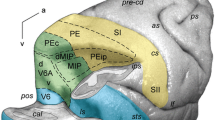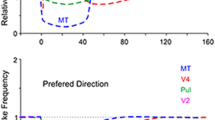Summary
The visual properties of 77 dorsolateral pontine nucleus (DLPN) cells were studied in two alert monkeys. In 41 cells, presentation of a moving random dot background pattern, while the monkeys fixated a stationary spot, elicited modulations in discharge rate that were related either to (i) the velocity of background motion in a specific direction or to (ii) only the direction of background movement. Thirty-six DLPN cells exhibited responses to small, 0.6–1.7 deg, visual stimuli. Nine such cells exhibited non-direction selective receptive fields that were eccentric from the fovea. During fixation of a stationary bluish spot, the visual responses of 27 DLPN cells to movement of a small, white “test” spot were characterized by two components: (1) as the test spot crossed the fovea in a specific direction, transient velocity-related increases in discharge rate occurred and (2) a maintained, smaller increase in activity was observed for the duration of test spot movement in the preferred direction. This DLPN activity associated with small visual stimuli was also observed during smooth-pursuit eye movements when, due to imperfect tracking, retinal image motion of the target produced slip in the same direction. These preliminary results suggest that the DLPN could supply the smooth-pursuit system with signals concerning the direction and velocity of target image motion on the retina.
Similar content being viewed by others
References
Baker JF, Petersen SE, Newsome WT, Altaian JM (1981) Visual response properties of neurons in four extrastriate visual areas of the owl monkey (Aotus trivirgatus): a quantitative comparison of medial, dorsomedial, dorsolateral, and middle temporal areas. J Neurophysiol 45: 397–416
Brodal P (1978) The cortico-pontine projection in the rhesus monkey. Origin and principles of organization. Brain 101: 251–283
Brodal P (1979) The pontocerebellar projection in the rhesus monkey: an experimental study with retrograde axonal transport of horseradish peroxidase. Neuroscience 4: 193–208
Brodal P (1982) Further observations on the cerebellar projections from the pontine nuclei and the nucleus reticularis tegmenti pontis in the rhesus. J Comp Neurol 204: 44–55
Fischer B, Boch R (1981) Selection of visual targets activates prelunate cortical cells in trained rhesus monkey. Exp Brain Res 41: 431–433
Fries W (1981) The projection from striate and prestriate visual cortex onto the pontine nuclei in the macaque monkey. Soc Neurosci Abstr 7: 762
Fries W, Albus K (1980) Responses of pontine nuclei cells to electrical stimulation of the lateral and suprasylvian gyrus in the cat. Brain Res 188: 255–268
Glickstein M, Cohen JL, Dixon B, Gibson A, Hollins M, Labossiere E, Robinson F (1980) Corticopontine visual projections in macaque monkeys. J Comp Neurol 190: 209–229
Harting JK (1977) Descending pathways from the superior colliculus: An autoradiographic analysis in the rhesus monkey (Macaca mulatta). J Comp Neurol 173: 583–612
Judge SJ, Richmond BJ, Chu FC (1980) Implantation of magnetic search coils for measurement of eye position: an improved method. Vision Res 20: 535–538
Kase M, Miller DC, Noda H (1980) Discharges of Purkinje cells and mossy fibers in the cerebellar vermis of the monkey during saccadic eye movements and fixation. J Physiol (Lond) 300: 539–555
Langer TP, Fuchs AF, Chubb MC, Scudder C (1980) Afferent projections to the monkey flocculus. Soc Neurosci Abstr 6: 477
Lisberger SG, Fuchs AF (1978) Role of primate flocculus during rapid behavioral modification of vestibulo-ocular reflex. I. Purkinje cell activity during visually guided horizontal smooth pursuit eye movement and passive head rotation. J Neurophysiol 41: 733–763
Miles FA, Fuller JH, Braitman DJ, Dow BM (1980) Long-term adaptive changes in primate vestibulo-ocular reflex. III. Electro-physiological observations in flocculus of normal monkeys. J Neurophysiol 43: 1437–1476
Mountcastle VB, Lynch JC, Georgopoulos A, Sakata H, Acuna C (1975) Posterior parital association cortex of the monkey: Command functions for operations within extrapersonal space. J Neurophysiol 38: 871–908
Mower G, Gibson A, Glickstein M (1979) Tectopontine pathways in the cat: Laminar distribution of cells of origin and visual properties of target cells in dorsolateral pontine nucleus. J Neurophysiol 42: 1–15
Noda H (1981) Visual mossy fiber inputs to the flocculus of the monkey. Ann NY Acad Sci 374: 465–475
Noda H, Suzuki DA (1979a) The role of the flocculus of the monkey in saccadic eye movements. J Physiol (Lond) 294: 317–334
Noda H, Suzuki DA (1979b) The role of the flocculus of the monkey in fixation and smooth pursuit eye movements. J Physiol (Lond) 294: 335–348
Robinson DA (1963) A method of measuring eye movement using a scieral search coil in a magnetic field. IEEE Trans Biomed Eng BME-10: 137–145
Robinson DA (1976) The physiology of pursuit eye movements. In: Monty RA, Senders JW (eds) Eye movements and psychological processes. Lawrence Erlbaum Assoc Publ, New Jersey, pp 19–32
Robinson DL, Goldberg ME, Stanton GB (1978) Parietal association cortex in the primate: Sensory mechanisms and behavioral modulations. J Neurophysiol 41: 910–932
Suzuki DA, Keller EL (1982) Vestibular signals in the posterior vermis of the alert monkey cerebellum. Exp Brain Res 47: 145–147
Suzuki DA, Noda H, Kase M (1981) Visual and pursuit eye movement-related activity in posterior vermis of monkey cerebellum. J Neurophysiol 46: 1120–1139
Van Essen DC, Maunsell JHR, Bixby JL (1981) The middle temporal area in the macaque: myeloarchitecture, connections, functional properties and topographic organization. J Comp Neurol 199: 293–326
Waespe W, Henn V (1981) Visual-vestibular interaction in the flocculus of the alert monkey. II. Purkinje cell activity. Exp Brain Res 43: 349–360
Weber JT, Harting JK (1980) The efferent projections of the pretectal complex: an autoradiographic and horseradish peroxidase analysis. Brain Res 194: 1–28
Wiesendanger R, Wiesendanger M, Ruegg DG (1979) An anatomical investigation of the corticopontine projection in the primate. (Macaca fascicularis and Saimiri sciureus). — II. The projection from frontal and parietal association areas. Neuroscience 4: 747–765
Young LR (1971) Pursuit eye tracking movements. In: Bach-y-Rita P, Collins CC, Hyde JE (eds) The control of eye movements. Academic Press, New York, pp 429–444
Zeki SM (1974) Functional organization of a visual area in the posterior bank of the superior temporal sulcus of the rhesus monkey. J Physiol (Lond) 236: 549–573
Author information
Authors and Affiliations
Additional information
Dedication. This paper is dedicated to Dr. Kitsuya Iwama, Emeritus Professor of Osaka University Medical School, on his retirement. The first author is grateful for the inspiration and guidance that Dr. Iwama provided during the early part of the author's education in neurophysiology.
This study was supported by NSF Grant BNS-8107111, NIH Grant R01 EY04552-01, and the Smith-Kettlewell Eye Research Foundation
Rights and permissions
About this article
Cite this article
Suzuki, D.A., Keller, E.L. Visual signals in the dorsolateral pontine nucleus of the alert monkey: Their relationship to smooth-pursuit eye movements. Exp Brain Res 53, 473–478 (1984). https://doi.org/10.1007/BF00238178
Received:
Accepted:
Issue Date:
DOI: https://doi.org/10.1007/BF00238178




